The so-called RF energy application uses heated electromagnetic radiation to heat the article or provide kinetic energy for various processes. At this stage, this energy is generally generated by a magnetron and will be produced by an all-solid-state semiconductor chain in the future, namely solid-state RF energy. Solid-state RF energy has unprecedented control range and even energy distribution, and quickly adapts to changing load conditions. This technology has unlimited potential and its market is expected to grow to $1.4 billion by 2020.
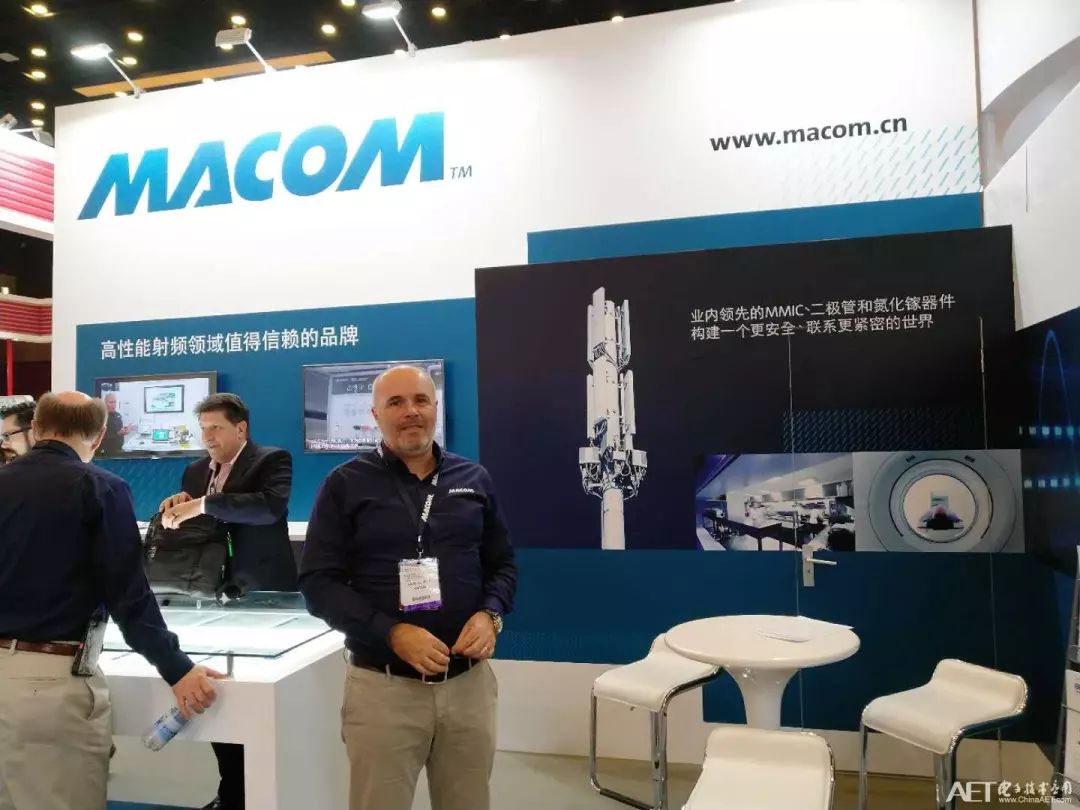
Mark Murphy
Senior Director, RF Power Marketing and Business Development, MACOM
According to Mark Murphy, senior director of RF power marketing and business development at MACOM, solid-state RF energy can be widely used in microwave ovens, automotive ignition, lighting systems, and including RF plasma lighting, raw material drying, blood and tissue heating and ablation. Industrial, scientific and medical applications. It has the advantages that other solutions do not have: low voltage drive, semiconductor reliability, small form factor and an "all solid state" footprint. The most exciting feature of solid-state RF energy may be the fast frequency, phase, and power agility compensated by ultra-high precision. Overall, the technology enables unprecedented process control, even energy distribution, and rapid adaptation to changing load conditions.
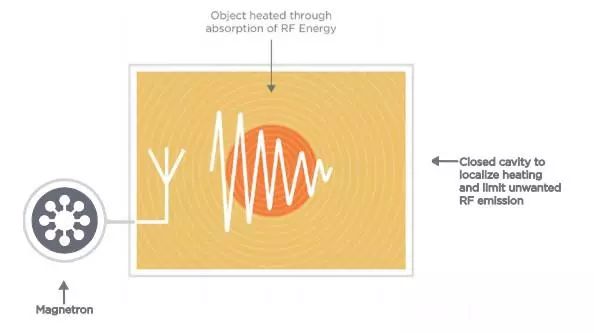
Traditional RF energy generation (top) VS solid-state RF energy generation (below)
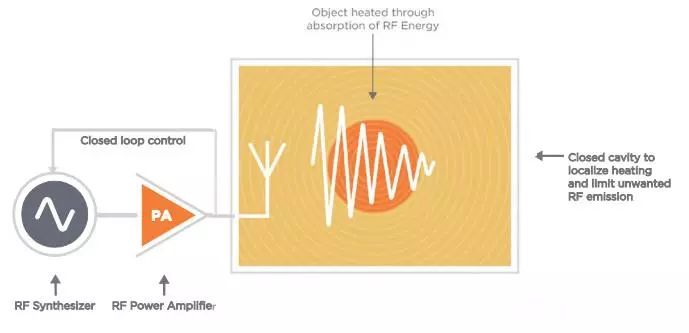
Given the many advantages of solid-state RF energy as a highly efficient and controllable source of heat and power, this technology has an invaluable market opportunity to not only improve existing RF energy applications, but also to develop new energy applications.
Application 1: Solid cooking
One of the main targets for RF energy is the traditional microwave oven, which is now powered by magnetrons, which are electrons that interact primarily with magnetic fields. The magnetron has a simple switching function that controls the energy placed in the oven for an average life of 500 to 1000 hours. At present, standard chain restaurants use magnetron-powered microwaves to heat customers' food. Considering the number of tableware prepared each day, the lifetime of magnetron microwaves is very limited.
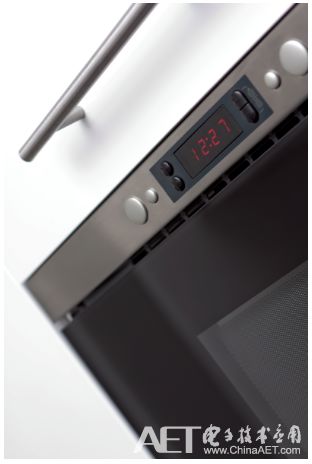
With RF transistors, microwave cooking can be completely changed. RF transistors produce an ultra-high-precision, controlled energy field that is sensitive to the response of the controller, enabling optimal and precise use and distribution of RF energy. Solid-state RF energy offers unparalleled advantages through alternative solutions including low-voltage drive, high efficiency, semiconductor-based reliability, smaller form factor, and space occupied by solid-state electronics. Perhaps the most compelling benefit is the power agility and ultra-precision of this technology, resulting in uniform energy distribution, unprecedented range of process control, and rapid adaptation to changing load conditions. In addition, solid state RF transistors are easy to use for more than 10 years.
Essentially, this means that by using RF energy instead of magnetrons, we can achieve solid, highly controlled cooking in a microwave oven. The rotating disk in the microwave oven does not need to evenly distribute heat. In contrast, microwave ovens can be programmed to target specific areas of different energies, ultimately resulting in more thorough and efficient cooking.
Application 2: Plasma lighting
Plasma lamps have been powered by magnetrons since their inception, and the average life of magnetrons is expected to be between 500 and 1000 hours. This is an important consideration when evaluating the value of a plasma lamp. In this regard, the US Naval Observatory provides a tool to calculate the number of night hours in a given time period (ie, the time when the entire sun is below the horizon). In Los Angeles, for example, the average daily night time in August this year was 10 hours and 9 minutes, and the total of one night's night time was 313 hours. If it is continuously lit during these nighttime periods, the life of the plasma lamp powered by the magnetron is as short as 2 months and up to 4 months. Therefore, applications such as outdoor, street, stadium or area lighting will not benefit from magnetron-based plasma lighting due to the high cost of replacing the bulb.

However, with the performance advantages of GaN technology, plasma illumination based on solid-state RF energy greatly extends the life of the light source, providing an unprecedented market opportunity for plasma lamps. Due to the high efficiency and long life of solid state RF energy, plasma lighting can now offer extremely high value for large area lighting applications. The RF energy driven by GaN not only provides higher efficiency and longer life, but also achieves controllable energy. Ultra-high-precision light bulbs powered by RF energy are able to adapt to the movement of time or passing pedestrians or vehicles and convert the emitted light accordingly. With RF energy, power is no longer wasted in vacant locations, which further extends the life of the bulb.
Although this is an attractive concept, the cost structure of solid-state chips is more expensive than magnetrons, making RF energy applications a luxury. However, with the excellent efficiency and gain performance of MACOM's silicon-based GaN products, plasma lighting is expected to dominate the lighting market for the first time.
Application 3: Medical Applications
Today's RF medical devices are designed to heat biological cells and tissues, and are suitable for medical treatments with RF/microwave ablation to bacterial sterilization with minimal invasiveness. Compared with traditional semiconductor technology, GaN-based RF medical devices have key advantages in precision control, high power, and higher efficiency: (1) Precision control - GaN can be used at ISM frequencies below 3 GHz Provides high efficiency while also supporting 5.8 GHz and higher frequencies. The higher the frequency, the shorter the wavelength, which enhances the precise control of the RF energy field. This improves the accuracy of the treatment while reducing the risk of damaging adjacent tissues and organs. (2) High power and higher efficiency - The original power density of gallium nitride is much higher than that of LDMOS, and the efficiency is increased by 10%. This allows more energy to be directed to the treatment site, dehydrating and/or burning off the tumor and unwanted tissue while reducing power consumption and thermal limitations at the system level.

RF/microwave ablation is currently used to eliminate cancerous tumors, and this situation will continue to improve as GaN enters the RF medical device market.
Thermotherapy is rapidly becoming another core target for RF energy. This therapy is often implemented in conjunction with other cancer treatments, and doctors can use targeted RF energy to increase the temperature of body tissue in the patient's cancer site. Controlled calories (104 oF to 108oF) act on cancer cells and reduce cancer cell replication, but do not interfere with DNA replication in healthy cells. This technology has great potential to become the mainstream cancer treatment method for the next few years.
In the future, GaN-based RF medical devices will be used to heat blood and organs during blood transfusion and transplantation. When transfused, RF energy allows the stored frozen blood to be heated quickly and evenly without harmful toxins, allowing rapid blood transfusion in an emergency. Similarly, the ability to freeze and rapidly thaw donated organs without causing cell damage can extend the shelf life of the organ and increase the likelihood of successful donor/acceptor matching over long periods of time and long distances.
Application 4: Industrial heating and drying
From an industrial perspective, RF energy is not a new technology. For many years, RF dryers have been industrially heated and dried for materials that do not respond well to conventional methods. Ceramic, glass and fiberglass applications require a process that does not crack when dry. In the event that other methods fail completely, in many cases, RF energy provides the only option for drying these materials because it removes moisture in a controlled manner.
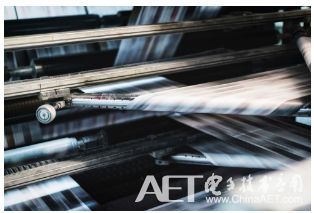
Innovations in RF technology will enable greater efficiency and better control throughout the heating and drying process. Previous RF applications required the use of magnetrons to generate energy, but by using semiconductor devices, the overall system cost structure was reduced, enabling higher accuracy and better control. In addition to food processing, industrial heating and drying, and energy industry applications, RF energy has many other applications. For example, for grains, beans, and seeds, RF drying methods can remove moisture from grains, beans, and seeds more quickly, reduce processing time, and maximize crop potential and nutritional value; wood, plastics, drugs, paper, and Textiles can use RF energy to reduce the cost of industrial processes and improve the efficiency of industrial processes; RF energy is expected to help oil companies to extract more oil, better control the oil extraction process, reduce waste, increase return on investment and reduce The cost of heating and mining processes, while changing the environmental impact of oil extraction.
Silicon-based GaN: the preferred alternative to LDMOS
All of the solid-state RF energy applications described above require RF devices that support these systems to find the best balance between performance, power efficiency, compact size, and reliability, and to push them to the most reasonable price point for commercial mainstream applications. In this process, the choice of process technology for RF devices has become a key factor.
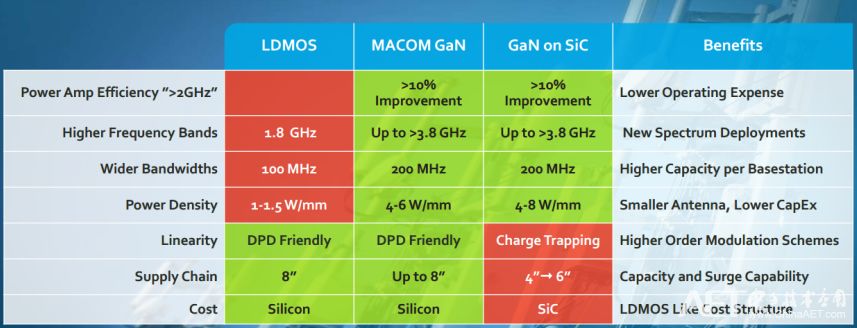
Throughout the RF semiconductor market, laterally diffused metal oxide semiconductor (LDMOS) technology has been playing a leading role for decades. Until two or three years ago, this balance changed, and silicon-based GaN (GaN-on-Si) technology became the technology of choice for replacing traditional LDMOS technology.
Compared to LDMOS, the performance advantages of silicon-based GaN have been firmly established - it can provide more than 70% power efficiency, increase power per unit area by 4 to 6 times, and can be extended to high frequencies. At the same time, comprehensive test data has confirmed that silicon-based gallium nitride meets stringent reliability requirements, and its RF performance and reliability are comparable to or even surpass the expensive GaN-on-SiC replacement technology.
In the future, silicon-based GaN-based RF technology is expected to replace the old magnetron and spark plug technology, giving full play to the value and potential of commercial solid-state RF energy applications such as cooking, lighting and automotive ignition. We believe the energy/fuel efficiency of these applications and Heating and illumination accuracy will make a qualitative leap in the near future.
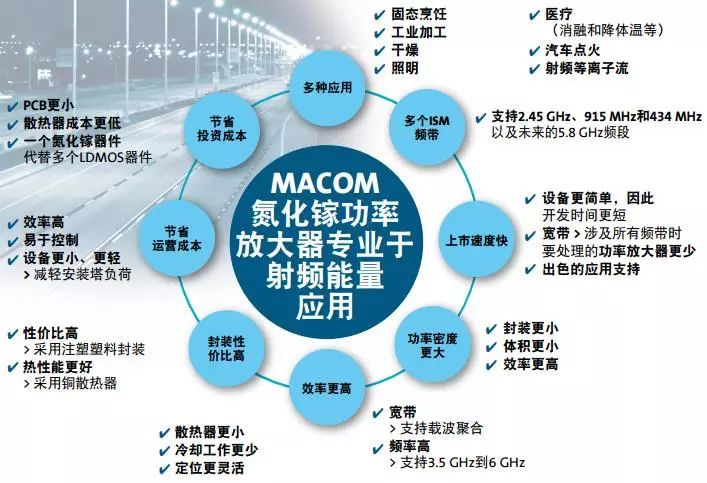
Advantages of MACOM GaN
MACOM offers the only portfolio of silicon-based GaN products in the RF and microwave industries and is committed to applying silicon-based GaN technology to the mainstream RF market and applications. Not long ago, MACOM and ST reached an agreement on the development of silicon-based GaN wafers, which was produced by ST for use by MACOM in various RF applications. Through this agreement, MACOM is able to expand its silicon-based wafer supply source, which is expected to increase silicon wafer production capacity and improve cost structure to replace existing silicon LDMOS technology and accelerate the popularity of silicon-based gallium nitride in the mainstream market.
New RF Energy Kit
MACOM has launched a RF energy system development kit, MATK-102425-300, designed to help commercial OEMs quickly and easily adjust their product designs to integrate GaN-based RF energy sources into cooking, lighting, industrial heating/drying Among various applications such as dry, medical/pharmaceutical and automotive ignition systems.
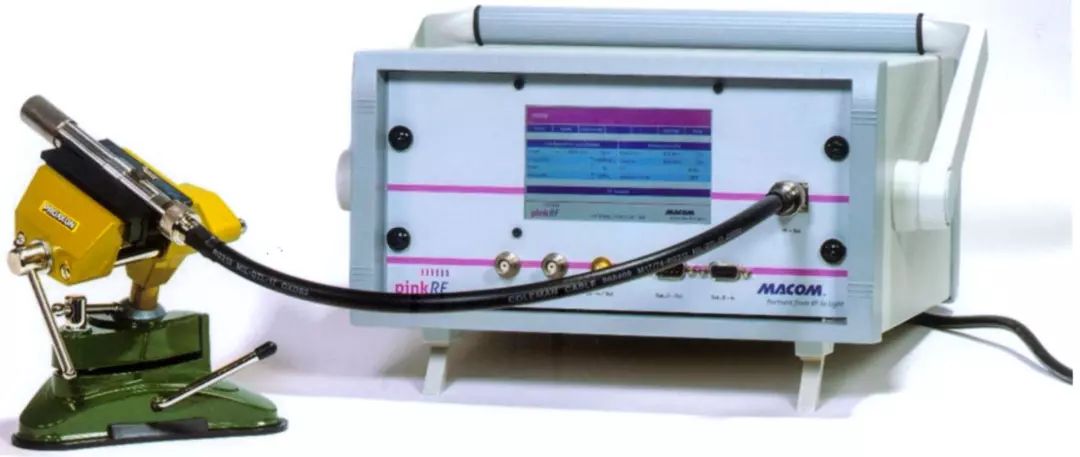
The kit can also run complex recipes individually or in conjunction with other controllers that remotely program or embed any number of RF vectors (power, phase, frequency, time, and energy) to control complex or variable processes. No special integration is required when the tool is connected to a power amplifier. For RF energy engineers, the MATK-102425-300 can be used to control, optimize and industrialize RF energy applications and their associated controllers.
Compared to LDMOS-based valence transistors, the MACOM silicon-based GaN power transistors included with this RF energy kit are up to 10% more power efficient, a major advantage of continuous wave RF energy applications. During use, the higher the efficiency, the lower the power consumption and the lower the operating cost. This toolkit helps system designers simplify and accelerate product development, making it easy to fine-tune RF energy output levels to maximize efficiency and performance. It combines the advantages of MACOM's silicon-based GaN power transistors with intuitive, flexible software and signal control capabilities, eliminating the need for speculation in the RF energy design phase, helping to reduce time-to-market.
Mark Murphy concluded that solid-state RF energy technology has the full range of advantages from consumer goods to industrial, scientific and medical systems and infrastructure, and is expected to incite the entire market segment in the future.
The anti-glare technology used in the Matte Protective Film can reduce glare to eliminate eye fatigue, and make it easier to watch under direct light, which is more friendly to your eyes.
In order to let you enjoy it for a long time, the Frosted Screen Protector uses durable military-grade TPU material, which has strong durability and scratch resistance. It protects the screen from unnecessary scratches.
It has good anti-fingerprint ability, sweat will not remain on the screen surface, and it is easy to clean without affecting touch sensitivity or response speed.
The adhesive layer ensures that you stick the Protective Film in a stress-free manner and maintain a strong adhesion without leaving any sticky residue.
If you want to know more about Matte Screen Protector products, please click the product details to view the parameters, models, pictures, prices and other information about Matte Screen Protector.
Whether you are a group or an individual, we will try our best to provide you with accurate and comprehensive information about the Matte Screen Protector!
Matte Screen Protector, Frosted Screen Protector, Matt Screen Protector, Matte Hydrogel Film, Matt Protective Film, Anti-Glare Screen Protector
Shenzhen Jianjiantong Technology Co., Ltd. , https://www.jjtphonesticker.com
